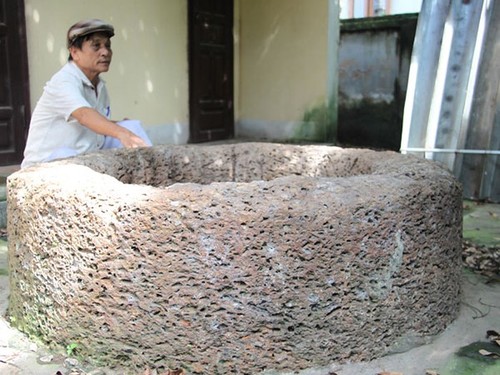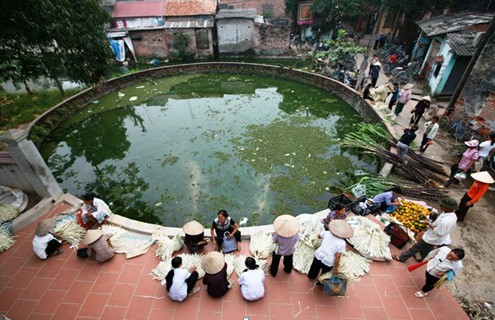
The ancient well made of laterite bricks in Dai Phung village (Photo: anninhthudo.vn)
|
Many Vietnamese people see the water well as the source of their village’s vitality, prosperity, and abundance.
Ancient wells on the northern plains are still being used daily. Many of them have been in use for hundreds of years. Wells frequently figure in folklore.
As a source of water for daily life, village wells are considered a community treasure. They are often near main roads to make access to the water more convenient. Most water wells are built of cobbles stones or laterite bricks which have stood strong for hundreds of years. Laterite helps to filter the water and make it purer and fresher.
Archaeologist Dr. Nguyen Tien Dong described to us the structure of the 600-year-old water well in Dai Phung village in Hanoi’s outlying district of Dan Phuong.
“The well is monolithic. This is a typical characteristics of the well. Four layers of laterite are laid at the bottom with cobbles underneath. The structure produces water of high quality,” said Dong.
Nguyen Thi Tuat of Dac So commune in Hoai Duc district told VOV about the water of the Gia village well: “Before we had tap water, all the villagers, even people from other villages, used the water from this well. This well water grows beansprouts which are sweeter, whiter, and bigger. I wake up at 4 a.m. to fetch my well water.”
Although many Vietnamese villages now have water piped into every home thanks to Vietnam’s new rural development policy, the village well continues to play an important role in people’s social life.
Locals believe that, supported by both heaven and earth, water from the ancient wells is endless and sacred and the source of the village’s blessings and vitality. Bui Vinh Thuy of Dai Phung village said: “On the first and fifteenth day of every lunar month, we draw water from the village well and dedicate it to Buddha, the Genies, and the ancestors. The most notable characteristic of the water here is that it is warm in the winter and cool in the summer. Legend has it that the well was built by Cham ethnic people.”

The water well in Chuong village (Photo: vnexpress.net)
|
A village well is often a place where people gather to communicate with each other.
Le Van Hong of Chuong village in Hanoi’s outlying district of Thanh Oai told us about his village’s well: “My brother and I used to play near the village well, which is located next to a pagoda and a tall bell-tower. Young villagers often gathered there to chat and flirt. It helped us forget our weariness so we could continue to work the next day.”